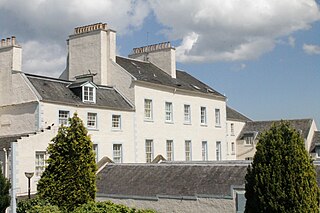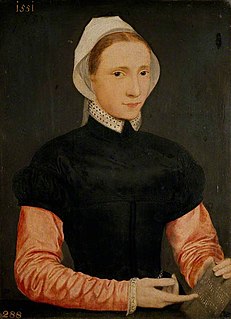
The Canongate is a street and associated district in central Edinburgh, the capital city of Scotland. The street forms the main eastern length of the Royal Mile while the district is the main eastern section of Edinburgh's Old Town. It began when David I of Scotland, by the Great Charter of Holyrood Abbey c.1143, authorised the Abbey to found a burgh separate from Edinburgh between the Abbey and Edinburgh. The burgh of Canongate that developed was controlled by the Abbey until the Scottish Reformation when it came under secular control. In 1636 the adjacent city of Edinburgh bought the feudal superiority of the Canongate but it remained a semi-autonomous burgh under its own administration of bailies chosen by Edinburgh magistrates, until its formal incorporation into the city in 1856.

Queensberry House is a building of 17th-century origin which is now a Category A listed building. It stands on the south side of the Canongate, Edinburgh, Scotland, incorporated into the Scottish Parliament complex on its north-west corner. It contains the office of the Presiding Officer, two Deputy Presiding Officers, the Parliament's Chief Executive, and other staff.

George Keith, 5th Earl Marischal (c. 1553–1623) was a Scottish nobleman and Earl Marischal. He succeeded as earl on 7 October 1581, upon the death of his grandfather, William Keith, 4th Earl Marischal.

Adrian Vanson was court portrait painter to James VI of Scotland.

George Seton V, 7th Lord Seton (1531–1586), was a Lord of the Parliament of Scotland, Master of the Household of Mary, Queen of Scots, and Provost of Edinburgh. He was the eldest son of George Seton, 6th Lord Seton, and Elizabeth Hay, a daughter of John Hay, 3rd Lord Hay of Yester. His childhood and schooling were in France.
John Seton, Lord Barns was a Scottish diplomat, courtier and judge.
John Arnot of Birswick (Orkney) (1530–1616) was a 16th-century Scottish merchant and landowner who served as Lord Provost of Edinburgh from 1587 to 1591 and from 1608 to death. He was Deputy Treasurer to King James VI.

Whitefoord House (or occasionally Whiteford House is an 18th-century former mansion on the Canongate section of the Royal Mile in Edinburgh. It stands on the north side of the Royal Mile obscured by more modern buildings, under a backdrop of Calton Hill.
Patrick Gray, 5th Lord Gray, was a Scottish landowner
Alexander Abernethy, 6th Lord Saltoun was a Scottish landowner and courtier.

George Learmonth of Balcomie was a Scottish landowner.
Thomas Kennedy of Bargany was a Scottish courtier and landowner.
John Acheson was a Scottish goldsmith, mining entrepreneur, and official of the mint.
David Seton of Parbroath was a Scottish courtier and administrator.

Helen Leslie, Lady Newbattle (1520-1594) was a Scottish aristocrat and supporter of Mary, Queen of Scots.
Alexander Clark of Balbirnie was a Scottish merchant and Provost of Edinburgh. He was closely involved with English diplomacy.
Archibald Stewart was a Scottish merchant and Provost of Edinburgh.
John Kinloch or Killoch was keeper of the royal tennis courts, a post master and stable owner in 16th-century Edinburgh and the proprietor of house used for lodgings and banquets.
Michael Gilbert was an Edinburgh goldsmith and financier.

Jerome Bowie was a servant of James VI of Scotland.









